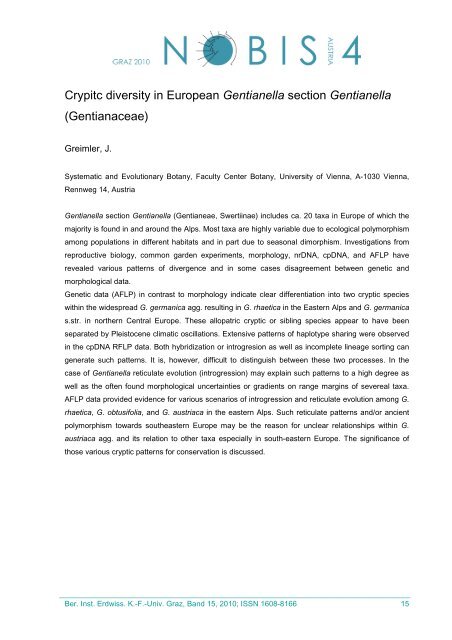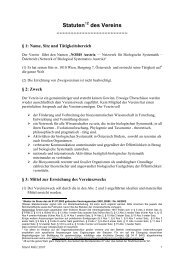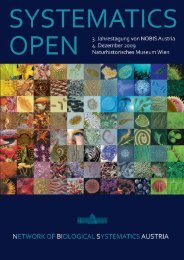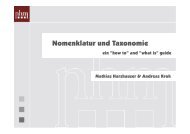4. Jahrestagung von NOBIS Austria 2. - 3. Dezember 2010
4. Jahrestagung von NOBIS Austria 2. - 3. Dezember 2010
4. Jahrestagung von NOBIS Austria 2. - 3. Dezember 2010
Create successful ePaper yourself
Turn your PDF publications into a flip-book with our unique Google optimized e-Paper software.
Crypitc diversity in European Gentianella section Gentianella<br />
(Gentianaceae)<br />
Greimler, J.<br />
Systematic and Evolutionary Botany, Faculty Center Botany, University of Vienna, A-1030 Vienna,<br />
Rennweg 14, <strong>Austria</strong><br />
Gentianella section Gentianella (Gentianeae, Swertiinae) includes ca. 20 taxa in Europe of which the<br />
majority is found in and around the Alps. Most taxa are highly variable due to ecological polymorphism<br />
among populations in different habitats and in part due to seasonal dimorphism. Investigations from<br />
reproductive biology, common garden experiments, morphology, nrDNA, cpDNA, and AFLP have<br />
revealed various patterns of divergence and in some cases disagreement between genetic and<br />
morphological data.<br />
Genetic data (AFLP) in contrast to morphology indicate clear differentiation into two cryptic species<br />
within the widespread G. germanica agg. resulting in G. rhaetica in the Eastern Alps and G. germanica<br />
s.str. in northern Central Europe. These allopatric cryptic or sibling species appear to have been<br />
separated by Pleistocene climatic oscillations. Extensive patterns of haplotype sharing were observed<br />
in the cpDNA RFLP data. Both hybridization or introgresion as well as incomplete lineage sorting can<br />
generate such patterns. It is, however, difficult to distinguish between these two processes. In the<br />
case of Gentianella reticulate evolution (introgression) may explain such patterns to a high degree as<br />
well as the often found morphological uncertainties or gradients on range margins of severeal taxa.<br />
AFLP data provided evidence for various scenarios of introgression and reticulate evolution among G.<br />
rhaetica, G. obtusifolia, and G. austriaca in the eastern Alps. Such reticulate patterns and/or ancient<br />
polymorphism towards southeastern Europe may be the reason for unclear relationships within G.<br />
austriaca agg. and its relation to other taxa especially in south-eastern Europe. The significance of<br />
those various cryptic patterns for conservation is discussed.<br />
_____________________________________________________________________________<br />
Ber. Inst. Erdwiss. K.-F.-Univ. Graz, Band 15, <strong>2010</strong>; ISSN 1608-8166 15






